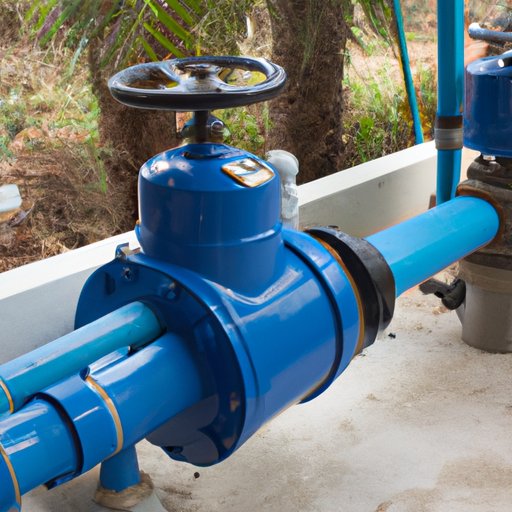Introduction
When you rely on a well for your water supply, it’s important to make sure that you have enough water pressure for all of your needs. Low water pressure can be caused by a variety of issues, ranging from worn-out components to clogged valves. This article will explore some of the most common causes of low water pressure and provide step-by-step instructions for how to increase your water pressure on a well pump.
Check the Pressure Tank
One of the first steps in increasing your water pressure is to inspect the pressure tank. The pressure tank is responsible for storing water and maintaining a consistent pressure level when the well pump is running. If the pressure tank is damaged or clogged, it won’t be able to do its job properly, resulting in low water pressure.
To check if the pressure tank is damaged or clogged, you’ll need to take off the lid and inspect the inside. Look for any signs of corrosion or blockages, and if you find any, you’ll need to replace the pressure tank. You should also check the air pressure in the pressure tank and make sure it’s at the recommended level for your well pump.
Replace the Well Pump
If the pressure tank is in good condition, then the next step is to inspect the well pump. An old or worn-out well pump may not be able to generate enough pressure to meet your needs, so replacing it with a newer model may be the best option. Newer models are designed to handle higher pressures and can provide a more consistent flow of water.
When choosing a new well pump, make sure to select one with a higher rating than your old one. You’ll also want to make sure that the pump is compatible with your existing pressure tank and other components of your well system. Once you’ve selected a new pump, you’ll need to install it according to the manufacturer’s instructions.

Increase the Pressure Switch Setting
The pressure switch is responsible for turning the well pump on and off as needed. By adjusting the pressure switch setting, you can increase the water pressure in your well. To adjust the pressure switch setting, you’ll need to turn off the power to the pump and unscrew the cover of the pressure switch. Inside the pressure switch, you’ll see two adjustment screws: one for the cut-in pressure and one for the cut-out pressure.
Adjusting the cut-in pressure will increase the water pressure in your well. However, it’s important to note that increasing the cut-in pressure too much can cause damage to the pump, so make sure to adjust it gradually and keep an eye on the pressure gauge. Increasing the pressure switch setting can also help reduce the amount of time the pump runs, which can save energy and money.
Clean or Replace the Foot Valve
The foot valve is located at the bottom of the well and is responsible for preventing water from flowing back into the well when the pump is off. If the foot valve is clogged or damaged, it can significantly reduce the water pressure in your well. To inspect the foot valve, you’ll need to remove it from the well and check for any signs of damage or debris.
If the foot valve is clogged, you can clean it with a brush and warm, soapy water. If it’s damaged, you’ll need to replace it with a new one. Make sure to choose a foot valve that’s compatible with your well pump and pressure tank. Installing a new foot valve can help increase the water pressure in your well.
Check for Leaks
Leaks in the pipes and fittings can also cause low water pressure. To check for leaks, start by turning off all of the faucets in your home and then check the water pressure gauge. If the pressure drops, then you likely have a leak somewhere in your system. To locate the leak, you’ll need to inspect all of the pipes and fittings in your well system.
Eliminating leaks in your well system can help increase the water pressure and reduce your water bill. In addition, fixing leaks can help protect your well from contamination, which can be harmful to your health.
Install a Booster Pump
If none of the above steps have helped to increase your water pressure, then you may need to install a booster pump. A booster pump is a device that increases the water pressure in your well by pushing water through the pipes and fittings. Booster pumps come in a variety of sizes and can be installed either above or below ground. Installing a booster pump can help increase the water pressure in your well and ensure that you have enough water for all of your needs.
Conclusion
Low water pressure can be caused by a variety of issues, ranging from worn-out components to clogged valves. This article has explored some of the most common causes of low water pressure and provided step-by-step instructions for how to increase your water pressure on a well pump. From inspecting the pressure tank to replacing the well pump to installing a booster pump, these tips can help you get high-pressure water from your well.
If you’re still having trouble getting enough water pressure from your well, contact a professional for assistance. They can inspect your well system and identify the source of the problem. With the right help, you can get the water pressure you need for all of your needs.
(Note: Is this article not meeting your expectations? Do you have knowledge or insights to share? Unlock new opportunities and expand your reach by joining our authors team. Click Registration to join us and share your expertise with our readers.)
